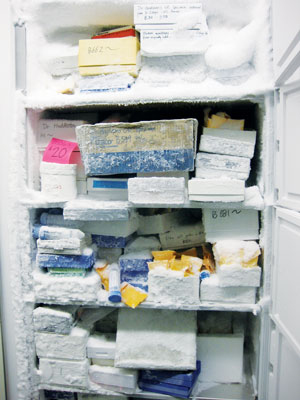October 19, 2009 - By Susan Ipaktchian

The medical school's "Cash for Clunkers" program rewards faculty who get rid of energy-hog freezers, like the one above, used to store lab products.
To freeze or not to freeze. That was the dilemma facing John Coller, PhD, director of the Stanford Functional Genomics Facility, last year.
The facility’s three freezers that store biologic materials at minus-80 degrees were almost completely full, and buying a new one would cost about $10,000. The facility produces and analyzes microarrays for both human and mouse tissues, and so the staff must stock a supply of plasmids, cloned cells and other materials in its freezers. As Coller weighed his options, he was invited to join a pilot program to test a method of converting the frozen materials to a format that would allow them to be stored at room temperature.
But first, Coller had to make an inventory of all the freezers’ contents so that he knew exactly what was in there. After a few weeks, the inventory was complete and Coller had identified about 15,000 samples for conversion to room-temperature storage, freeing up about half of a freezer.
Medical school leaders are hoping other labs will follow Coller’s example as they roll out their own version of a “Cash for Clunkers” program. The aim is to reduce the use of the older, energy-guzzling freezers that store proteins, blood and other biological specimens at minus-80 degrees.
The freezer retirement plan is part of a larger sustainability effort at the medical school—one that is now expanding to encourage individual actions from faculty, staff and students to help cut power costs, conserve water and turn food waste into compost.
“All of us want to do what we can to reduce our impact on the environment,” said Marcia Cohen, the school’s senior associate dean for finance and administration. “This is important to us, particularly when we are counting every dollar in the budget.”
And the freezer retirement program is the latest step in the efforts to reduce energy use, costs and carbon dioxide output.
Ruth Norris, the director of finance and administration for the biochemistry department who is helping to coordinate the “clunkers” program, said there are two big downsides to these freezers. One is the ongoing energy and chilled-water costs, and the other is the precious square footage they use. According to a report prepared for the pilot program, each freezer takes up about 30 square feet; in 2008, the school had 1,959 low-temp and minus-80 freezers, occupying 58,000 square feet. With the addition of new faculty, that number is estimated to grow to 2,500 freezers needing 75,000 square feet by 2013.
To counteract that trend, the school is offering $170,000 in cash incentives during this fiscal year to spur labs to get rid of their older, minus-80 freezers. The incentives range in size from $2,300 to $11,500 for options that include eliminating a freezer entirely or converting the samples to a format that allows them to be safely stored at room temperature.
The catch—and it’s a big one—is that participation in the “clunkers” program requires taking an inventory of the existing freezer’s contents. Norris said that in many labs, postdocs and graduate students may have stored samples in the freezers and then left the school years ago, with no one tracking the contents. “The lab may have to reconstitute a sample just to figure out what it is,” she said.
Eleven medical school labs and one biology lab participated in the pilot project last year in which they converted some of their frozen samples for room-temperature storage. Greg Jensen, a management consultant for Sustainable BioVentures who led the pilot study, said that of the 1 million samples identified in the participating labs, 70,000 samples were converted—roughly the equivalent of two to three full freezers. Had the full 1 million samples been converted, Jensen estimated that it would have eliminated the need for 25-30 minus-80 freezers.
Coller said the process of converting the 15,000 samples from the genomics facility’s freezers took just a couple of days because it has robotic equipment that made the process move relatively quickly. He used the equipment to help another lab convert about 30,000 samples to the room-temperature format.
“I’m happy with the results,” he said. “The major benefit was being able to free up some freezer space and not having to buy another one.”
For other labs that are considering the process, Coller suggested that they test a few of their samples to determine which are most suitable for converting to room-temperature storage.
Details about the “clunkers” program are available online at http://medfacilities.stanford.edu/sustainability.
About Stanford Medicine
Stanford Medicine is an integrated academic health system comprising the Stanford School of Medicine and adult and pediatric health care delivery systems. Together, they harness the full potential of biomedicine through collaborative research, education and clinical care for patients. For more information, please visit med.stanford.edu.